TM3011 - Introduction to the Experience and Visitor Economy Report
VerifiedAdded on 2022/12/23
|8
|2498
|49
Report
AI Summary
This report provides a comprehensive overview of the hospitality industry, examining its scale, scope, and diversity. The introduction defines the industry's importance, encompassing lodging, food and beverage, and related services. The main body delves into the industry's scale, highlighting its rapid growth, revenue generation, and contribution to GDP, along with the number of employees. It explores the industry's scope, covering sectors such as travel and tourism, food and beverage, recreation, and lodging, while also detailing the range of products offered, including rooms, business centers, and restaurants. The report analyzes various ownership structures like franchise, privately owned, and leased models. The report also discusses both the positive and negative impacts of the hospitality industry, such as employment opportunities versus environmental concerns. Finally, the report concludes by recommending changes to improve business operations and promote corporate social responsibility. The report is intended for students of the Experience and Visitor Economy module TM3011.
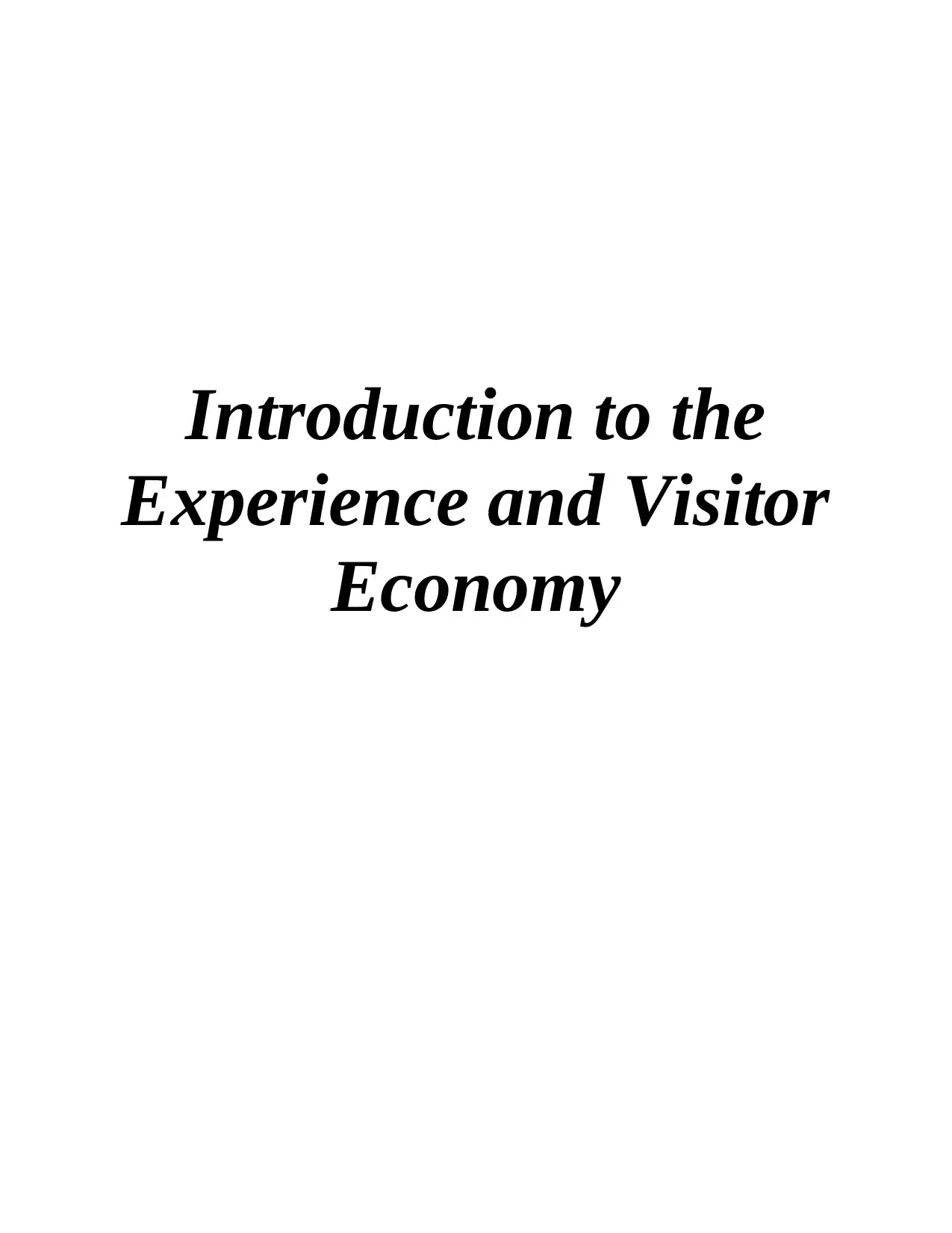
Introduction to the
Experience and Visitor
Economy
Experience and Visitor
Economy
Paraphrase This Document
Need a fresh take? Get an instant paraphrase of this document with our AI Paraphraser
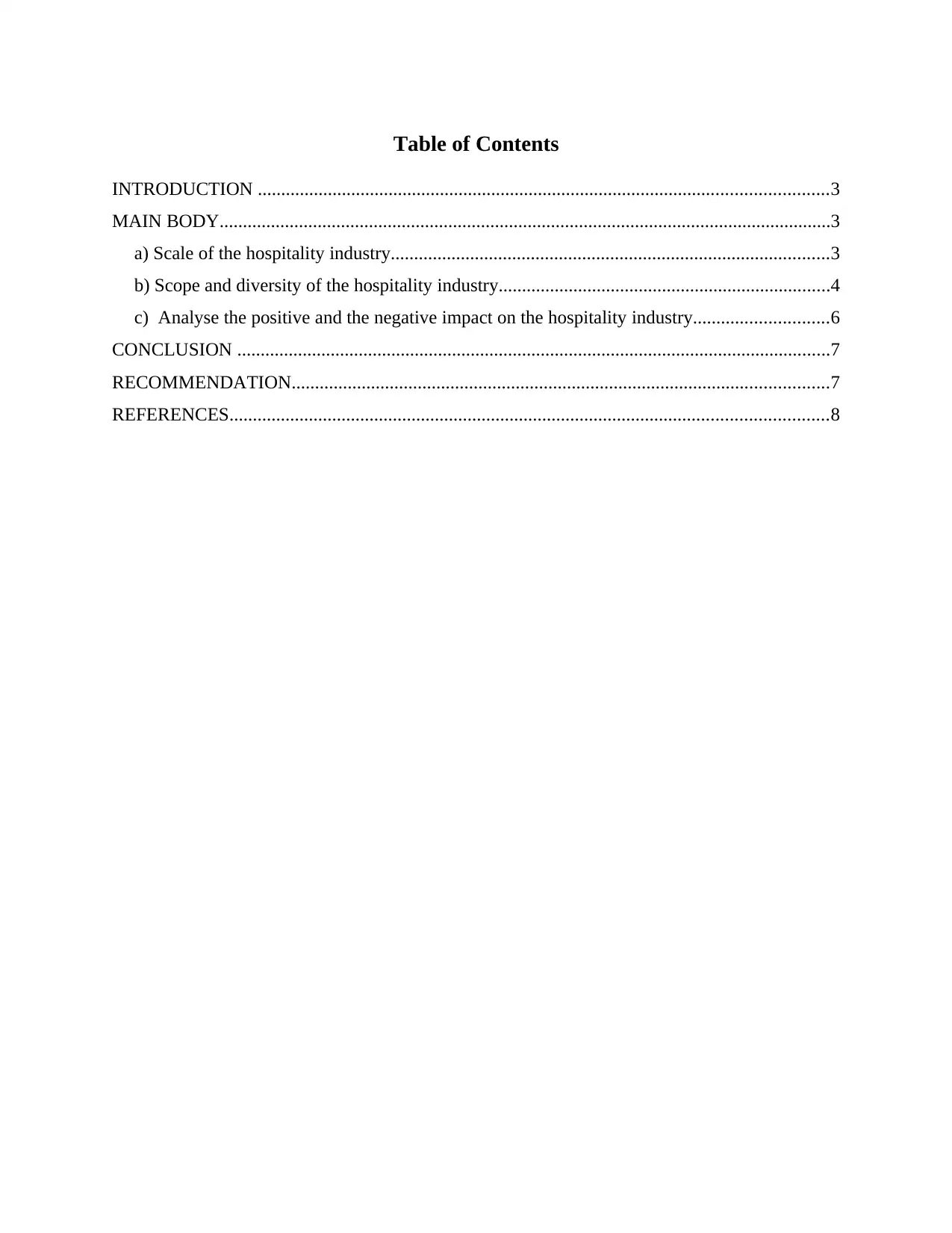
Table of Contents
INTRODUCTION ..........................................................................................................................3
MAIN BODY...................................................................................................................................3
a) Scale of the hospitality industry..............................................................................................3
b) Scope and diversity of the hospitality industry.......................................................................4
c) Analyse the positive and the negative impact on the hospitality industry.............................6
CONCLUSION ...............................................................................................................................7
RECOMMENDATION...................................................................................................................7
REFERENCES................................................................................................................................8
INTRODUCTION ..........................................................................................................................3
MAIN BODY...................................................................................................................................3
a) Scale of the hospitality industry..............................................................................................3
b) Scope and diversity of the hospitality industry.......................................................................4
c) Analyse the positive and the negative impact on the hospitality industry.............................6
CONCLUSION ...............................................................................................................................7
RECOMMENDATION...................................................................................................................7
REFERENCES................................................................................................................................8
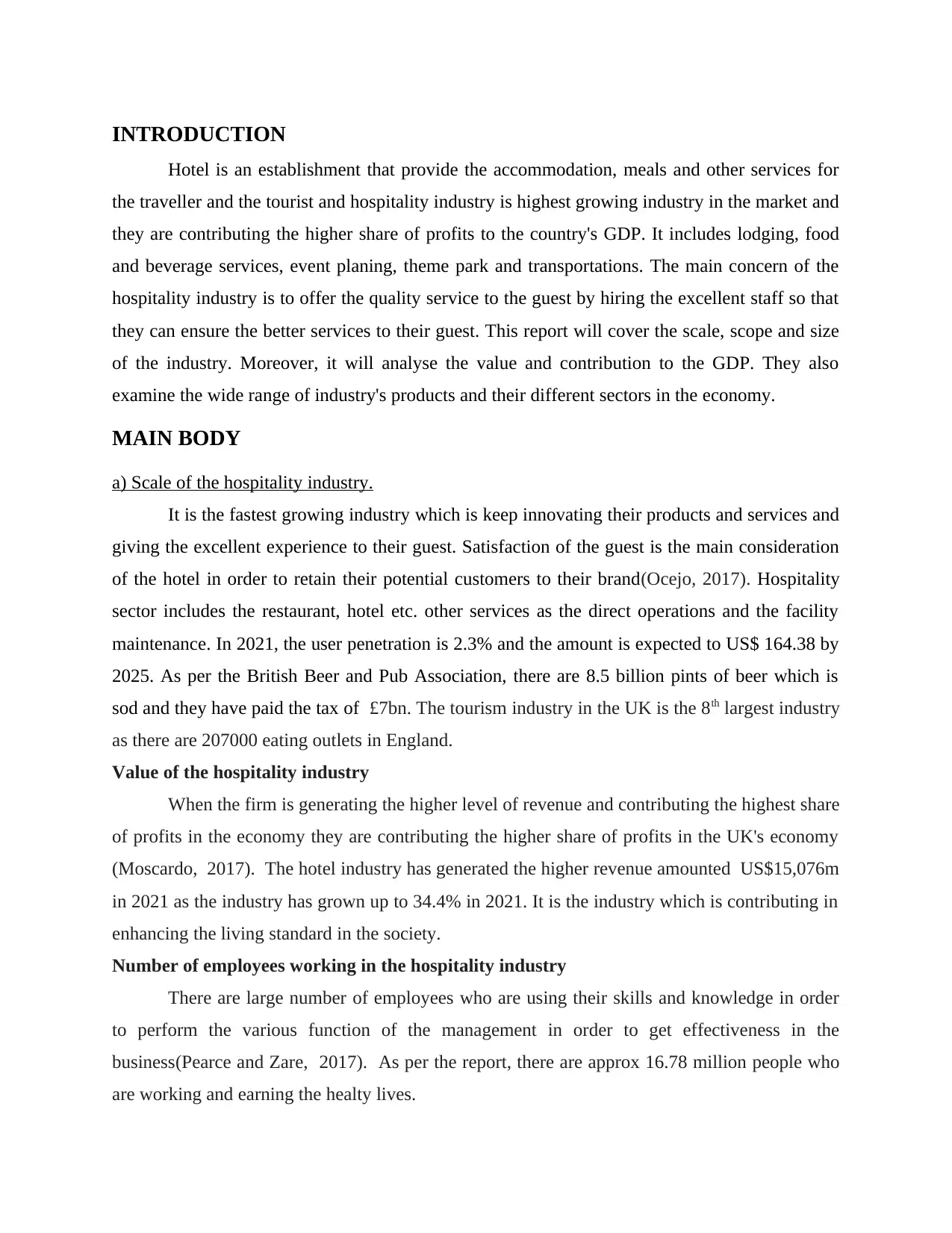
INTRODUCTION
Hotel is an establishment that provide the accommodation, meals and other services for
the traveller and the tourist and hospitality industry is highest growing industry in the market and
they are contributing the higher share of profits to the country's GDP. It includes lodging, food
and beverage services, event planing, theme park and transportations. The main concern of the
hospitality industry is to offer the quality service to the guest by hiring the excellent staff so that
they can ensure the better services to their guest. This report will cover the scale, scope and size
of the industry. Moreover, it will analyse the value and contribution to the GDP. They also
examine the wide range of industry's products and their different sectors in the economy.
MAIN BODY
a) Scale of the hospitality industry.
It is the fastest growing industry which is keep innovating their products and services and
giving the excellent experience to their guest. Satisfaction of the guest is the main consideration
of the hotel in order to retain their potential customers to their brand(Ocejo, 2017). Hospitality
sector includes the restaurant, hotel etc. other services as the direct operations and the facility
maintenance. In 2021, the user penetration is 2.3% and the amount is expected to US$ 164.38 by
2025. As per the British Beer and Pub Association, there are 8.5 billion pints of beer which is
sod and they have paid the tax of £7bn. The tourism industry in the UK is the 8th largest industry
as there are 207000 eating outlets in England.
Value of the hospitality industry
When the firm is generating the higher level of revenue and contributing the highest share
of profits in the economy they are contributing the higher share of profits in the UK's economy
(Moscardo, 2017). The hotel industry has generated the higher revenue amounted US$15,076m
in 2021 as the industry has grown up to 34.4% in 2021. It is the industry which is contributing in
enhancing the living standard in the society.
Number of employees working in the hospitality industry
There are large number of employees who are using their skills and knowledge in order
to perform the various function of the management in order to get effectiveness in the
business(Pearce and Zare, 2017). As per the report, there are approx 16.78 million people who
are working and earning the healty lives.
Hotel is an establishment that provide the accommodation, meals and other services for
the traveller and the tourist and hospitality industry is highest growing industry in the market and
they are contributing the higher share of profits to the country's GDP. It includes lodging, food
and beverage services, event planing, theme park and transportations. The main concern of the
hospitality industry is to offer the quality service to the guest by hiring the excellent staff so that
they can ensure the better services to their guest. This report will cover the scale, scope and size
of the industry. Moreover, it will analyse the value and contribution to the GDP. They also
examine the wide range of industry's products and their different sectors in the economy.
MAIN BODY
a) Scale of the hospitality industry.
It is the fastest growing industry which is keep innovating their products and services and
giving the excellent experience to their guest. Satisfaction of the guest is the main consideration
of the hotel in order to retain their potential customers to their brand(Ocejo, 2017). Hospitality
sector includes the restaurant, hotel etc. other services as the direct operations and the facility
maintenance. In 2021, the user penetration is 2.3% and the amount is expected to US$ 164.38 by
2025. As per the British Beer and Pub Association, there are 8.5 billion pints of beer which is
sod and they have paid the tax of £7bn. The tourism industry in the UK is the 8th largest industry
as there are 207000 eating outlets in England.
Value of the hospitality industry
When the firm is generating the higher level of revenue and contributing the highest share
of profits in the economy they are contributing the higher share of profits in the UK's economy
(Moscardo, 2017). The hotel industry has generated the higher revenue amounted US$15,076m
in 2021 as the industry has grown up to 34.4% in 2021. It is the industry which is contributing in
enhancing the living standard in the society.
Number of employees working in the hospitality industry
There are large number of employees who are using their skills and knowledge in order
to perform the various function of the management in order to get effectiveness in the
business(Pearce and Zare, 2017). As per the report, there are approx 16.78 million people who
are working and earning the healty lives.
⊘ This is a preview!⊘
Do you want full access?
Subscribe today to unlock all pages.

Trusted by 1+ million students worldwide
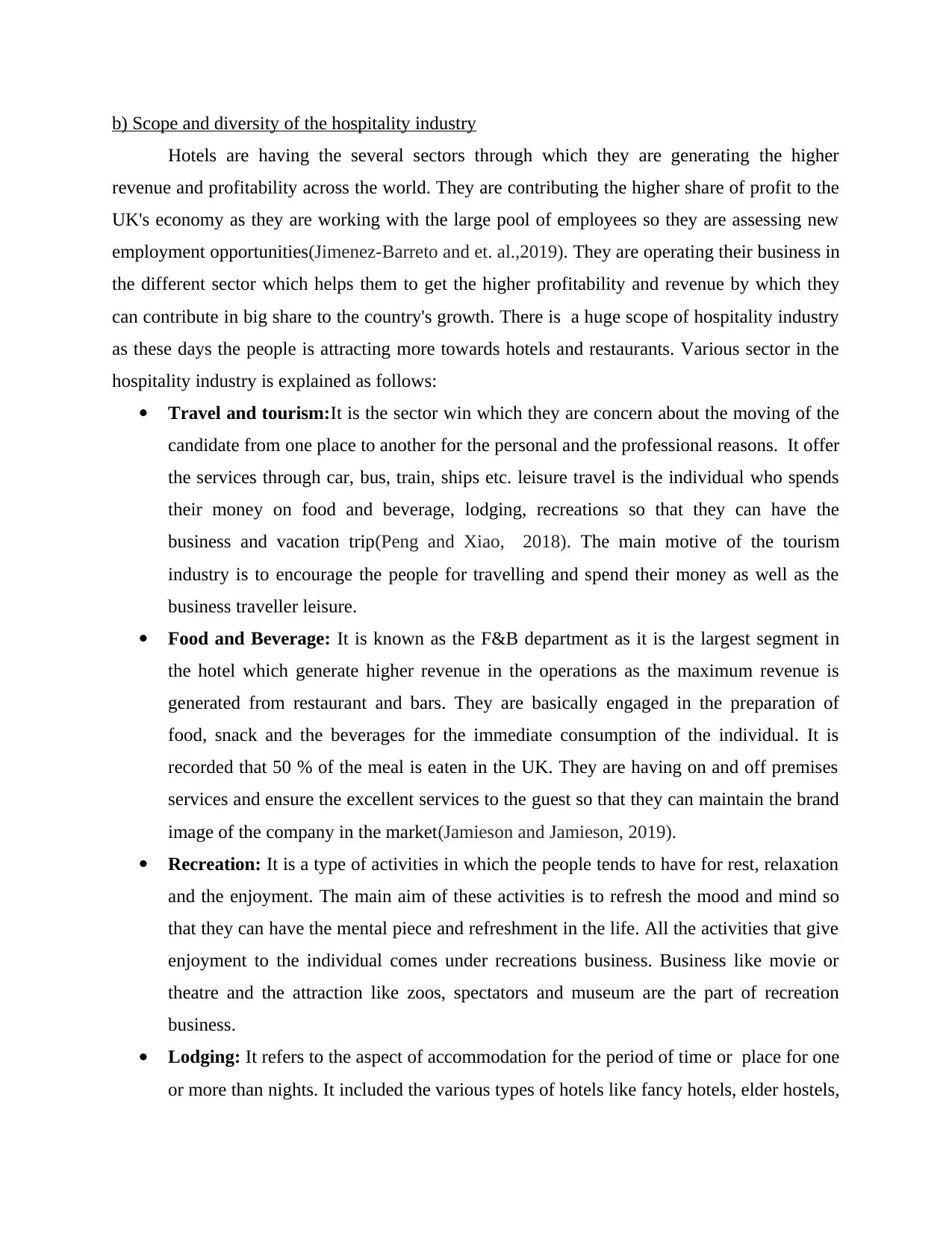
b) Scope and diversity of the hospitality industry
Hotels are having the several sectors through which they are generating the higher
revenue and profitability across the world. They are contributing the higher share of profit to the
UK's economy as they are working with the large pool of employees so they are assessing new
employment opportunities(Jimenez-Barreto and et. al.,2019). They are operating their business in
the different sector which helps them to get the higher profitability and revenue by which they
can contribute in big share to the country's growth. There is a huge scope of hospitality industry
as these days the people is attracting more towards hotels and restaurants. Various sector in the
hospitality industry is explained as follows:
Travel and tourism:It is the sector win which they are concern about the moving of the
candidate from one place to another for the personal and the professional reasons. It offer
the services through car, bus, train, ships etc. leisure travel is the individual who spends
their money on food and beverage, lodging, recreations so that they can have the
business and vacation trip(Peng and Xiao, 2018). The main motive of the tourism
industry is to encourage the people for travelling and spend their money as well as the
business traveller leisure.
Food and Beverage: It is known as the F&B department as it is the largest segment in
the hotel which generate higher revenue in the operations as the maximum revenue is
generated from restaurant and bars. They are basically engaged in the preparation of
food, snack and the beverages for the immediate consumption of the individual. It is
recorded that 50 % of the meal is eaten in the UK. They are having on and off premises
services and ensure the excellent services to the guest so that they can maintain the brand
image of the company in the market(Jamieson and Jamieson, 2019).
Recreation: It is a type of activities in which the people tends to have for rest, relaxation
and the enjoyment. The main aim of these activities is to refresh the mood and mind so
that they can have the mental piece and refreshment in the life. All the activities that give
enjoyment to the individual comes under recreations business. Business like movie or
theatre and the attraction like zoos, spectators and museum are the part of recreation
business.
Lodging: It refers to the aspect of accommodation for the period of time or place for one
or more than nights. It included the various types of hotels like fancy hotels, elder hostels,
Hotels are having the several sectors through which they are generating the higher
revenue and profitability across the world. They are contributing the higher share of profit to the
UK's economy as they are working with the large pool of employees so they are assessing new
employment opportunities(Jimenez-Barreto and et. al.,2019). They are operating their business in
the different sector which helps them to get the higher profitability and revenue by which they
can contribute in big share to the country's growth. There is a huge scope of hospitality industry
as these days the people is attracting more towards hotels and restaurants. Various sector in the
hospitality industry is explained as follows:
Travel and tourism:It is the sector win which they are concern about the moving of the
candidate from one place to another for the personal and the professional reasons. It offer
the services through car, bus, train, ships etc. leisure travel is the individual who spends
their money on food and beverage, lodging, recreations so that they can have the
business and vacation trip(Peng and Xiao, 2018). The main motive of the tourism
industry is to encourage the people for travelling and spend their money as well as the
business traveller leisure.
Food and Beverage: It is known as the F&B department as it is the largest segment in
the hotel which generate higher revenue in the operations as the maximum revenue is
generated from restaurant and bars. They are basically engaged in the preparation of
food, snack and the beverages for the immediate consumption of the individual. It is
recorded that 50 % of the meal is eaten in the UK. They are having on and off premises
services and ensure the excellent services to the guest so that they can maintain the brand
image of the company in the market(Jamieson and Jamieson, 2019).
Recreation: It is a type of activities in which the people tends to have for rest, relaxation
and the enjoyment. The main aim of these activities is to refresh the mood and mind so
that they can have the mental piece and refreshment in the life. All the activities that give
enjoyment to the individual comes under recreations business. Business like movie or
theatre and the attraction like zoos, spectators and museum are the part of recreation
business.
Lodging: It refers to the aspect of accommodation for the period of time or place for one
or more than nights. It included the various types of hotels like fancy hotels, elder hostels,
Paraphrase This Document
Need a fresh take? Get an instant paraphrase of this document with our AI Paraphraser
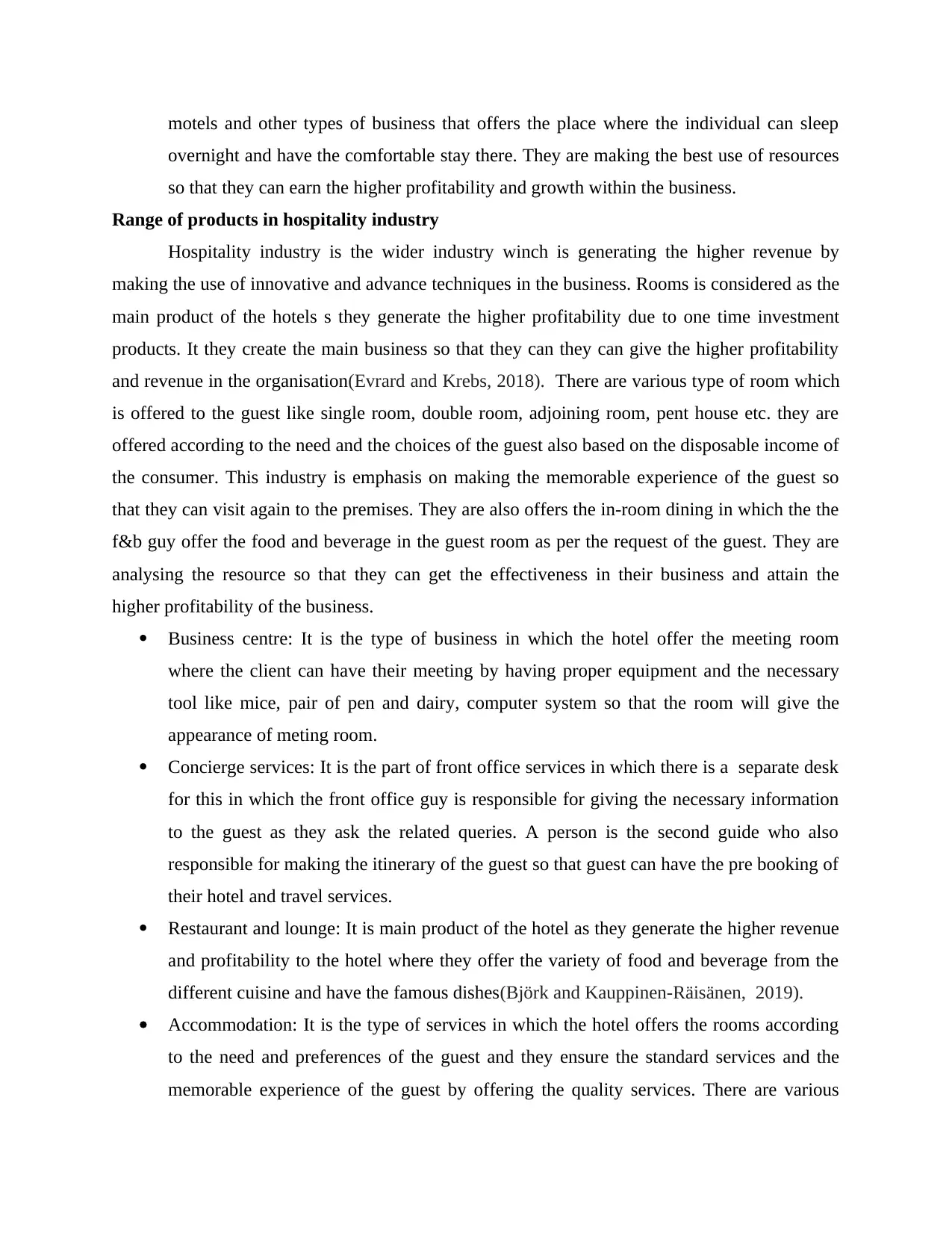
motels and other types of business that offers the place where the individual can sleep
overnight and have the comfortable stay there. They are making the best use of resources
so that they can earn the higher profitability and growth within the business.
Range of products in hospitality industry
Hospitality industry is the wider industry winch is generating the higher revenue by
making the use of innovative and advance techniques in the business. Rooms is considered as the
main product of the hotels s they generate the higher profitability due to one time investment
products. It they create the main business so that they can they can give the higher profitability
and revenue in the organisation(Evrard and Krebs, 2018). There are various type of room which
is offered to the guest like single room, double room, adjoining room, pent house etc. they are
offered according to the need and the choices of the guest also based on the disposable income of
the consumer. This industry is emphasis on making the memorable experience of the guest so
that they can visit again to the premises. They are also offers the in-room dining in which the the
f&b guy offer the food and beverage in the guest room as per the request of the guest. They are
analysing the resource so that they can get the effectiveness in their business and attain the
higher profitability of the business.
Business centre: It is the type of business in which the hotel offer the meeting room
where the client can have their meeting by having proper equipment and the necessary
tool like mice, pair of pen and dairy, computer system so that the room will give the
appearance of meting room.
Concierge services: It is the part of front office services in which there is a separate desk
for this in which the front office guy is responsible for giving the necessary information
to the guest as they ask the related queries. A person is the second guide who also
responsible for making the itinerary of the guest so that guest can have the pre booking of
their hotel and travel services.
Restaurant and lounge: It is main product of the hotel as they generate the higher revenue
and profitability to the hotel where they offer the variety of food and beverage from the
different cuisine and have the famous dishes(Björk and Kauppinen-Räisänen, 2019).
Accommodation: It is the type of services in which the hotel offers the rooms according
to the need and preferences of the guest and they ensure the standard services and the
memorable experience of the guest by offering the quality services. There are various
overnight and have the comfortable stay there. They are making the best use of resources
so that they can earn the higher profitability and growth within the business.
Range of products in hospitality industry
Hospitality industry is the wider industry winch is generating the higher revenue by
making the use of innovative and advance techniques in the business. Rooms is considered as the
main product of the hotels s they generate the higher profitability due to one time investment
products. It they create the main business so that they can they can give the higher profitability
and revenue in the organisation(Evrard and Krebs, 2018). There are various type of room which
is offered to the guest like single room, double room, adjoining room, pent house etc. they are
offered according to the need and the choices of the guest also based on the disposable income of
the consumer. This industry is emphasis on making the memorable experience of the guest so
that they can visit again to the premises. They are also offers the in-room dining in which the the
f&b guy offer the food and beverage in the guest room as per the request of the guest. They are
analysing the resource so that they can get the effectiveness in their business and attain the
higher profitability of the business.
Business centre: It is the type of business in which the hotel offer the meeting room
where the client can have their meeting by having proper equipment and the necessary
tool like mice, pair of pen and dairy, computer system so that the room will give the
appearance of meting room.
Concierge services: It is the part of front office services in which there is a separate desk
for this in which the front office guy is responsible for giving the necessary information
to the guest as they ask the related queries. A person is the second guide who also
responsible for making the itinerary of the guest so that guest can have the pre booking of
their hotel and travel services.
Restaurant and lounge: It is main product of the hotel as they generate the higher revenue
and profitability to the hotel where they offer the variety of food and beverage from the
different cuisine and have the famous dishes(Björk and Kauppinen-Räisänen, 2019).
Accommodation: It is the type of services in which the hotel offers the rooms according
to the need and preferences of the guest and they ensure the standard services and the
memorable experience of the guest by offering the quality services. There are various
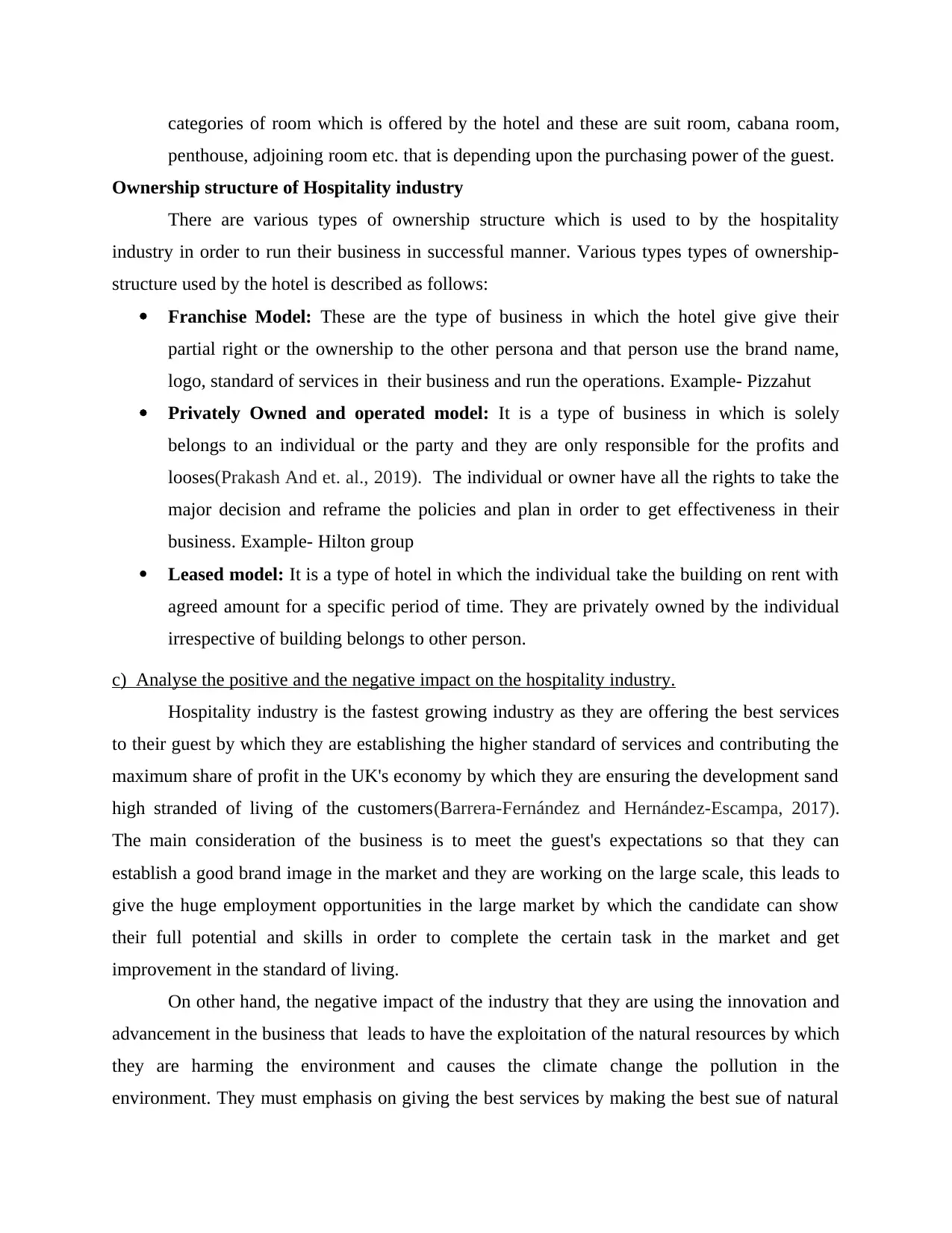
categories of room which is offered by the hotel and these are suit room, cabana room,
penthouse, adjoining room etc. that is depending upon the purchasing power of the guest.
Ownership structure of Hospitality industry
There are various types of ownership structure which is used to by the hospitality
industry in order to run their business in successful manner. Various types types of ownership-
structure used by the hotel is described as follows:
Franchise Model: These are the type of business in which the hotel give give their
partial right or the ownership to the other persona and that person use the brand name,
logo, standard of services in their business and run the operations. Example- Pizzahut
Privately Owned and operated model: It is a type of business in which is solely
belongs to an individual or the party and they are only responsible for the profits and
looses(Prakash And et. al., 2019). The individual or owner have all the rights to take the
major decision and reframe the policies and plan in order to get effectiveness in their
business. Example- Hilton group
Leased model: It is a type of hotel in which the individual take the building on rent with
agreed amount for a specific period of time. They are privately owned by the individual
irrespective of building belongs to other person.
c) Analyse the positive and the negative impact on the hospitality industry.
Hospitality industry is the fastest growing industry as they are offering the best services
to their guest by which they are establishing the higher standard of services and contributing the
maximum share of profit in the UK's economy by which they are ensuring the development sand
high stranded of living of the customers(Barrera-Fernández and Hernández-Escampa, 2017).
The main consideration of the business is to meet the guest's expectations so that they can
establish a good brand image in the market and they are working on the large scale, this leads to
give the huge employment opportunities in the large market by which the candidate can show
their full potential and skills in order to complete the certain task in the market and get
improvement in the standard of living.
On other hand, the negative impact of the industry that they are using the innovation and
advancement in the business that leads to have the exploitation of the natural resources by which
they are harming the environment and causes the climate change the pollution in the
environment. They must emphasis on giving the best services by making the best sue of natural
penthouse, adjoining room etc. that is depending upon the purchasing power of the guest.
Ownership structure of Hospitality industry
There are various types of ownership structure which is used to by the hospitality
industry in order to run their business in successful manner. Various types types of ownership-
structure used by the hotel is described as follows:
Franchise Model: These are the type of business in which the hotel give give their
partial right or the ownership to the other persona and that person use the brand name,
logo, standard of services in their business and run the operations. Example- Pizzahut
Privately Owned and operated model: It is a type of business in which is solely
belongs to an individual or the party and they are only responsible for the profits and
looses(Prakash And et. al., 2019). The individual or owner have all the rights to take the
major decision and reframe the policies and plan in order to get effectiveness in their
business. Example- Hilton group
Leased model: It is a type of hotel in which the individual take the building on rent with
agreed amount for a specific period of time. They are privately owned by the individual
irrespective of building belongs to other person.
c) Analyse the positive and the negative impact on the hospitality industry.
Hospitality industry is the fastest growing industry as they are offering the best services
to their guest by which they are establishing the higher standard of services and contributing the
maximum share of profit in the UK's economy by which they are ensuring the development sand
high stranded of living of the customers(Barrera-Fernández and Hernández-Escampa, 2017).
The main consideration of the business is to meet the guest's expectations so that they can
establish a good brand image in the market and they are working on the large scale, this leads to
give the huge employment opportunities in the large market by which the candidate can show
their full potential and skills in order to complete the certain task in the market and get
improvement in the standard of living.
On other hand, the negative impact of the industry that they are using the innovation and
advancement in the business that leads to have the exploitation of the natural resources by which
they are harming the environment and causes the climate change the pollution in the
environment. They must emphasis on giving the best services by making the best sue of natural
⊘ This is a preview!⊘
Do you want full access?
Subscribe today to unlock all pages.

Trusted by 1+ million students worldwide
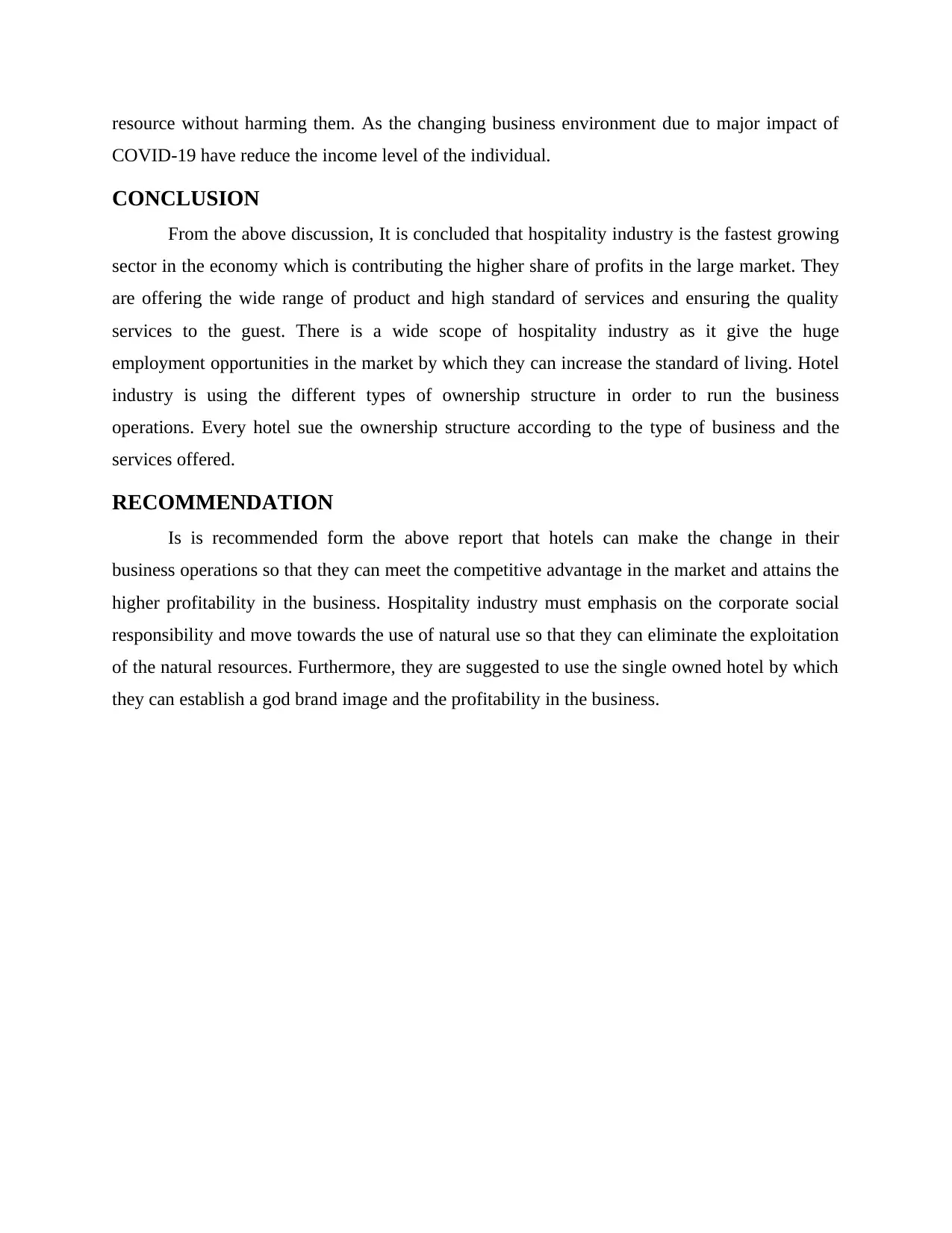
resource without harming them. As the changing business environment due to major impact of
COVID-19 have reduce the income level of the individual.
CONCLUSION
From the above discussion, It is concluded that hospitality industry is the fastest growing
sector in the economy which is contributing the higher share of profits in the large market. They
are offering the wide range of product and high standard of services and ensuring the quality
services to the guest. There is a wide scope of hospitality industry as it give the huge
employment opportunities in the market by which they can increase the standard of living. Hotel
industry is using the different types of ownership structure in order to run the business
operations. Every hotel sue the ownership structure according to the type of business and the
services offered.
RECOMMENDATION
Is is recommended form the above report that hotels can make the change in their
business operations so that they can meet the competitive advantage in the market and attains the
higher profitability in the business. Hospitality industry must emphasis on the corporate social
responsibility and move towards the use of natural use so that they can eliminate the exploitation
of the natural resources. Furthermore, they are suggested to use the single owned hotel by which
they can establish a god brand image and the profitability in the business.
COVID-19 have reduce the income level of the individual.
CONCLUSION
From the above discussion, It is concluded that hospitality industry is the fastest growing
sector in the economy which is contributing the higher share of profits in the large market. They
are offering the wide range of product and high standard of services and ensuring the quality
services to the guest. There is a wide scope of hospitality industry as it give the huge
employment opportunities in the market by which they can increase the standard of living. Hotel
industry is using the different types of ownership structure in order to run the business
operations. Every hotel sue the ownership structure according to the type of business and the
services offered.
RECOMMENDATION
Is is recommended form the above report that hotels can make the change in their
business operations so that they can meet the competitive advantage in the market and attains the
higher profitability in the business. Hospitality industry must emphasis on the corporate social
responsibility and move towards the use of natural use so that they can eliminate the exploitation
of the natural resources. Furthermore, they are suggested to use the single owned hotel by which
they can establish a god brand image and the profitability in the business.
Paraphrase This Document
Need a fresh take? Get an instant paraphrase of this document with our AI Paraphraser
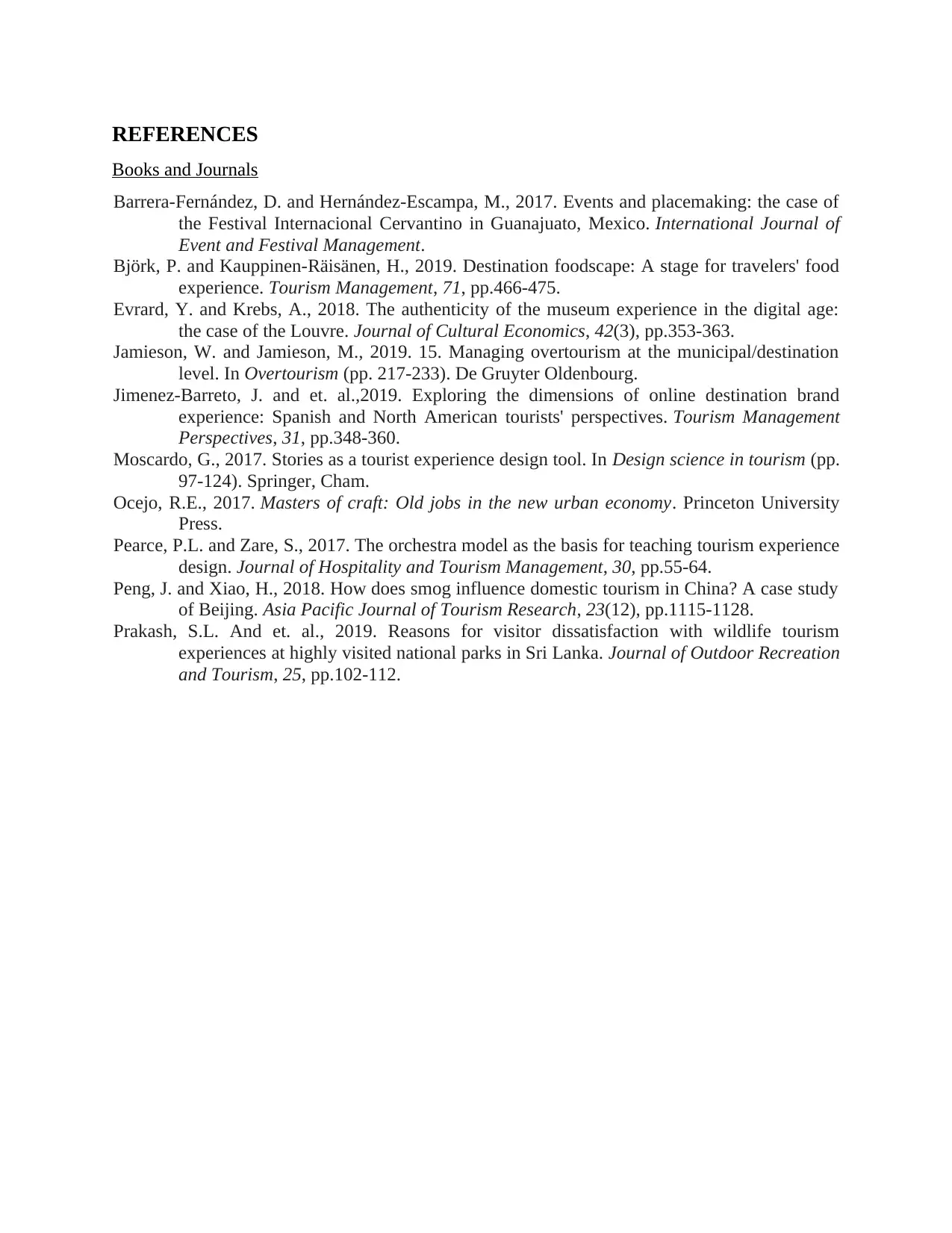
REFERENCES
Books and Journals
Barrera-Fernández, D. and Hernández-Escampa, M., 2017. Events and placemaking: the case of
the Festival Internacional Cervantino in Guanajuato, Mexico. International Journal of
Event and Festival Management.
Björk, P. and Kauppinen-Räisänen, H., 2019. Destination foodscape: A stage for travelers' food
experience. Tourism Management, 71, pp.466-475.
Evrard, Y. and Krebs, A., 2018. The authenticity of the museum experience in the digital age:
the case of the Louvre. Journal of Cultural Economics, 42(3), pp.353-363.
Jamieson, W. and Jamieson, M., 2019. 15. Managing overtourism at the municipal/destination
level. In Overtourism (pp. 217-233). De Gruyter Oldenbourg.
Jimenez-Barreto, J. and et. al.,2019. Exploring the dimensions of online destination brand
experience: Spanish and North American tourists' perspectives. Tourism Management
Perspectives, 31, pp.348-360.
Moscardo, G., 2017. Stories as a tourist experience design tool. In Design science in tourism (pp.
97-124). Springer, Cham.
Ocejo, R.E., 2017. Masters of craft: Old jobs in the new urban economy. Princeton University
Press.
Pearce, P.L. and Zare, S., 2017. The orchestra model as the basis for teaching tourism experience
design. Journal of Hospitality and Tourism Management, 30, pp.55-64.
Peng, J. and Xiao, H., 2018. How does smog influence domestic tourism in China? A case study
of Beijing. Asia Pacific Journal of Tourism Research, 23(12), pp.1115-1128.
Prakash, S.L. And et. al., 2019. Reasons for visitor dissatisfaction with wildlife tourism
experiences at highly visited national parks in Sri Lanka. Journal of Outdoor Recreation
and Tourism, 25, pp.102-112.
Books and Journals
Barrera-Fernández, D. and Hernández-Escampa, M., 2017. Events and placemaking: the case of
the Festival Internacional Cervantino in Guanajuato, Mexico. International Journal of
Event and Festival Management.
Björk, P. and Kauppinen-Räisänen, H., 2019. Destination foodscape: A stage for travelers' food
experience. Tourism Management, 71, pp.466-475.
Evrard, Y. and Krebs, A., 2018. The authenticity of the museum experience in the digital age:
the case of the Louvre. Journal of Cultural Economics, 42(3), pp.353-363.
Jamieson, W. and Jamieson, M., 2019. 15. Managing overtourism at the municipal/destination
level. In Overtourism (pp. 217-233). De Gruyter Oldenbourg.
Jimenez-Barreto, J. and et. al.,2019. Exploring the dimensions of online destination brand
experience: Spanish and North American tourists' perspectives. Tourism Management
Perspectives, 31, pp.348-360.
Moscardo, G., 2017. Stories as a tourist experience design tool. In Design science in tourism (pp.
97-124). Springer, Cham.
Ocejo, R.E., 2017. Masters of craft: Old jobs in the new urban economy. Princeton University
Press.
Pearce, P.L. and Zare, S., 2017. The orchestra model as the basis for teaching tourism experience
design. Journal of Hospitality and Tourism Management, 30, pp.55-64.
Peng, J. and Xiao, H., 2018. How does smog influence domestic tourism in China? A case study
of Beijing. Asia Pacific Journal of Tourism Research, 23(12), pp.1115-1128.
Prakash, S.L. And et. al., 2019. Reasons for visitor dissatisfaction with wildlife tourism
experiences at highly visited national parks in Sri Lanka. Journal of Outdoor Recreation
and Tourism, 25, pp.102-112.
1 out of 8
Related Documents
Your All-in-One AI-Powered Toolkit for Academic Success.
+13062052269
info@desklib.com
Available 24*7 on WhatsApp / Email
![[object Object]](/_next/static/media/star-bottom.7253800d.svg)
Unlock your academic potential
Copyright © 2020–2025 A2Z Services. All Rights Reserved. Developed and managed by ZUCOL.





